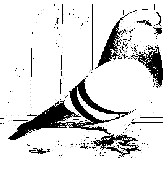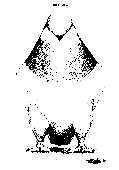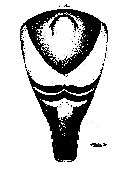The Giant Runt NPA Standard 1993:
 HEAD:
HEAD: Large, massive and broad, denoting strength,
and boldness. Top of skull being neither flat nor round, but oval as illustrated.
Back of skull should be well developed to give the bird a long head
.
BEAK: Should be broad, showing strength, of medium length. Fairly
thick, neither down faced or too straight, but as illustrated. Black in blues
and blacks, flesh in all other colors. A.O.C.'s may have
either.
WATTLE: Small, oval, equal in size and fine in texture.
EYE CERE: Neat, not too coarse, as illustrated. Note: Damson or plum
color in blues, red in all other colors.
EYES: Bright, clear, showing
health and vigor. Bull in whites, pearl in all other colors. No more than
three (3) point cut for off-colored eyes.
NECK: Medium in length, free from gullet and appearing broad and full
towards the breast. Neck feathers to be full enough to give us the neck
illustrated. It should flow into the back.
WINGS: Of moderate length and width in proportion to the size of the
bird. Folded close to the body and wrapping up over the rump as in a flying
pigeon. Wing butts should be held in such a way to give a look of added strength.
Should be thick and strong. Any sign of sails or open back should be cut
in points. Low wings are a fault and dragging wings should be cut or
disqualified.
BACK: Long, very broad at shoulders, straight when viewed from the
side, wedge shaped from the top view. Rump full enough to carry out this
wedge shape. Rump a very pale color almost white in both blues and silvers.
TAIL: Medium length with width governed by the wedge shape of the
bird. Lines to follow the sweep of the back and tip to be carried above the
floor while walking or standing in a natural position.
BREAST: Very full and as much breadth as is needed to give the Runt
a chesty look. Deep enough to match the deep keel.
KEEL: Very deep, long and straight. Cut in points up to (3) three;
if badly deformed, disqualified.
BODY: Long, deep and extra full. Very broad at the shoulders, fairly
wide through, but must show a taper. Belly section should be held tight so
that no looseness shows in the side view. Most of the weight must come from
the body and breast flesh and not from fat.
SHANK AND TOES: Medium in length, thick in bone. Feathers coming part
way down the leg to give the added look of strength. Or as illustrated. Legs
set well apart, but no sign of "bowlegs" or point "knock-knees" wanted. Feet
and toes free of feathers, with a slight point cut if lightly feathered.
Toe nails to be colored the same as the beak.
SIZE AND FEATHERING: Runts should be as large and heavy as possible
and close feathered enough to give the bird a trim look. Actual body structure
must determine size and not mere appearance or feather length. A compact,
nicely feathered, heavy boned, full bodied bird should win over a raw boned,
larger boned bird of less flesh. If a well put together bird is light in
weight, a judge may ask if the bird has been shipped a distance, and allow
for the trip


GENERAL TYPE MUST FOLLOW THE IDEAL PICTURE: When reading the standard
the illustration must be before the fancier. TYPE makes the breed and must
come first, even before great size. but if a perfectly typed bird is found
to be too small for a Giant Runt, it may be cut in points or even disqualified
by the judge. Such a bird should be used as a stock bird just as an extra
large, very poor bird should. The show pen is for perfection and our breed
must have both type and size. Very poor type or sloppy birds can be cut in
points or disqualified, no matter how large or heavy they are.
SEX AND AGE: As this standard is written to cover the adult male at
maturity, you will use your judgment when placing a hen or the young sexes.
The adult female should show less power and more curves than the male. Babies
or young females should have even less look of strength and more beautiful
curves. The illustration is also of the mature male, and adjustments should
be made by the judge when viewing it.
COLORS: We now allow ten (10) points for color and marking for all
standard colors known, except white and mismarks which have no color cut
in points. Unless a show will make a special class for the rare colors, they
will be put in the A.O.C. (any other color) class. In placing Champion, if
standard colors are competing, then the judge uses color points cuts. But
if a mismark or white is competing against standard colors, the judge is
to disregard the color points on all birds before him.
COLOR DESCRIPTIONS
-
Blue Bar: A deep even shade of blue in all sections of the body. The neck
should be darker shade with beetle green shade of sheen. White over rump.
The wings should show two well defined black bars. The tail is tipped with
a single black bar to match those on the wings. Golden-red or pearl iris.
Damson eye cere. Dark or black beak and toe nails.
-
Silver: A silvery blue tending to fawn color in all sections of the body,
with as little contrast as possible in the shade of the back, breast, wings
and tail. The neck should be a darker shade with a brilliant metallic luster.
White or fawn color over the rump. The wings to show two well defined bars
somewhat darker in color than the body, and the tail should be tipped with
a single bar to match those on the wings. Golden-red or pearl iris.
-
White: Pure white. Dark gravel eyes. Beet red cere. Pinkish white beak and
toe nails.
-
Red: Rich deep even shade of red throughout the surface with a red undercolor.
Neck color should show more sheen and luster, from green or beryl shades.
Light horn colored beak and toe nails.
-
Yellow: Deep golden sheen. Neck showing opalescent blending with golden hues.
Orange iris. Red eye cere. Horn colored beak and toe nails.
-
Dun: Good even dun color. Beak and toe nails the same color as the breast.
Golden-red iris. Flesh colored cere.
-
Black: Deep raven black with beetle green sheen. Golden red iris. Black colored
beak and toe nails.
-
Ash Red Bar: Body and wing color can be any variation of ash red. The wings
should show two well defined claret-red bars.
-
Ash Red Spread: Body and wing color to be a solid color of dark rich chestnut
red, showing a brilliant greenish shade of metallic luster. The tail to be
clear in color, ash gray, with the tail bar absent.
-
Ash Red Spread Dilute: Body and wing color to be a solid color of ash gray,
with black or brown flecking. In some birds the flecking willbe light or
absent. Birds that have white main tail or wing feathers will not be shown
in the ash red class. The ash red colors should have pearl eyes, horn color
beak and toe nails. Light colored birds to have flesh colored beaks and toe
nails, and dark colored birds to have dark horn beaks and toe nails.
-
Grizzle: Recognized only in blue pigment both intense and dilute. Blue Bar
- Head, neck, body, wing and tail color the same as the basic blue with the
addition of white flecks superimposed on top of the standard color. This
grizzling effect to be most noticeable upon the body, shoulder, head and
neck while nearly absent on the wing bars and tail bar. An evenly distributed
uniform grizzling is desired. More white to be allowed on the head, than
on body, shoulders, and neck. Neck feathers a bit darker shade showing a
rich sheen of primarily green and secondly purple. Birds that have white
main tail or wing feathers, will not be shown in the grizzle class. Pearl
or orange eyes. Dark or black beak and toe nails. Silver Bar - Head, neck,
body, wing and tail color the same as the basic silver with the addition
of white flecks superimposed on top of the standard color (silver). This
grizzling effect to be most noticeable upon the body, shoulders, head and
neck, while nearly absent upon the wing bars and tail bar. An evenly distributed
uniform grizzling is desired. More white to be allowed on the head, than
on body, shoulders, and neck. The neck should be a darker shade with a brilliant
metallic luster. Eye color, same as silver, with horn colored beak and toe
nails. Birds that have white main tail or wing feathers will not be shown
in the grizzle class.
SCALE OF POINTS
-
Head; 15 pts
-
Neck 10 pts
-
Back, Shoulders, Rump, 8 Tail 10 pts
-
Wings 15 pts
-
Type 20 pts
-
Body, Breast, & Size 20 pts
-
Legs, Feet, & Setting 10 pts
-
Color 10 pts
Note: Any cut above these points disqualifies.


 HEAD: Large, massive and broad, denoting strength,
and boldness. Top of skull being neither flat nor round, but oval as illustrated.
Back of skull should be well developed to give the bird a long head
HEAD: Large, massive and broad, denoting strength,
and boldness. Top of skull being neither flat nor round, but oval as illustrated.
Back of skull should be well developed to give the bird a long head 
 GENERAL TYPE MUST FOLLOW THE IDEAL PICTURE: When reading the standard
the illustration must be before the fancier. TYPE makes the breed and must
come first, even before great size. but if a perfectly typed bird is found
to be too small for a Giant Runt, it may be cut in points or even disqualified
by the judge. Such a bird should be used as a stock bird just as an extra
large, very poor bird should. The show pen is for perfection and our breed
must have both type and size. Very poor type or sloppy birds can be cut in
points or disqualified, no matter how large or heavy they are.
SEX AND AGE: As this standard is written to cover the adult male at
maturity, you will use your judgment when placing a hen or the young sexes.
The adult female should show less power and more curves than the male. Babies
or young females should have even less look of strength and more beautiful
curves. The illustration is also of the mature male, and adjustments should
be made by the judge when viewing it.
GENERAL TYPE MUST FOLLOW THE IDEAL PICTURE: When reading the standard
the illustration must be before the fancier. TYPE makes the breed and must
come first, even before great size. but if a perfectly typed bird is found
to be too small for a Giant Runt, it may be cut in points or even disqualified
by the judge. Such a bird should be used as a stock bird just as an extra
large, very poor bird should. The show pen is for perfection and our breed
must have both type and size. Very poor type or sloppy birds can be cut in
points or disqualified, no matter how large or heavy they are.
SEX AND AGE: As this standard is written to cover the adult male at
maturity, you will use your judgment when placing a hen or the young sexes.
The adult female should show less power and more curves than the male. Babies
or young females should have even less look of strength and more beautiful
curves. The illustration is also of the mature male, and adjustments should
be made by the judge when viewing it.